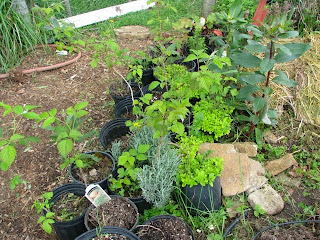I got this
tub off the sidewalk when a friend's neighbor tossed it out during a
remodel. It had no feet. But I didn't care, I had a plan that it was
perfect for.
There are a few luxuries in a dreary Oregon winter that make life really sing for me: A well stocked pantry, a place to sleep well and warmly and a good hot bath in a big tub.
Up 'till now I've had to settle for the first two, but when my little outdoor water heater stopped working after years of hard use, I decided to upgrade to the next size up.
We are not talking about breaking the bank though. The old one cost $115, the new one was $215.
The old heater was half as big and was just fine for doing dishes or taking an outdoor shower, but it put out a rather minimal amount of truly hot water, so it could never fill a big claw-foot tub with very hot water. The water would get cold faster than the tub got full.
With this new heater I can start filling the tub on a 38 degree day and have a hot, almost too hot, tub to soak in. In less than 20 minutes!
If you have ever had the pleasure of soaking in a hot tub under the stars, breathing perfect, fresh air, you know what a great experience it is. If you have not had this experience, please do!
Perhaps the uninitiated might think it sounds too cold, but I assure you it is only too cold for the minute it takes to drop your towel and jump in.
Getting out is zero trouble since your core temperature is so hot you could run naked in the snow without feeling the slightest chill. You can casually get out, dry off and dress. Maybe those Polar Bear Club swimmers aren't as nutty as they seem.
I have done a bit of crazy looking plumbing to get the water going where I want it. It looks like this in house walls too, but you can't see it like this.
I have done a lot of plumbing
over the years and I have never looked forward to it. Just like anything I
do around the Homestead it's always been several trips to the store and remembering how to do complex jobs like wiring and plumbing just about the time I finish the job.
This time I used PEX tubing for the first time and I used SharkBite hardware to connect it. I highly recommend the SharkBite joints, especially for beginner plumbers, since they require no special tools- you just shove the tubing in and it locks on. No leaks, no fuss. AND if you made a mistake you can fix it in a flash without losing any materials. With a little, inexpensive ($2.50) gadget, you can simply undo the connection and start over using the same materials!
In order to hook up the heater to three things and still have cold water to the sink, I had to do a little thinking outside the box.
I also bypassed the old nonworking faucet on the tub and used a hose-end shut off valve to regulate the water to the tub.
The tub was pretty dirty from sitting outside. But it cleaned up well. I had a little visitor before I got it running.
To cover the overflow hole, I screwed a canning jar lid and a gasket to a board on the backside.
This bath's outside, who cares if it overflows? And that Mod enables me to fill it to the brim. Luxury.





















































